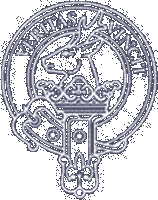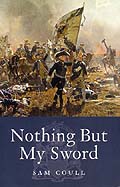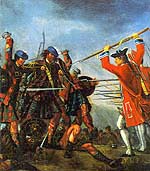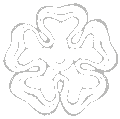
Clan Keith
Clan Keith Society USA, Inc. "The Keiths traced their origins back to an ancient Rhineland tribe called the Catti. Sometime in the first century BC, so the legend goes, the Catti fought the Romans in the Hercynian forest: their retreat took them by Katwyck on the Rhine to embark for Scotland from the coast of Holland. Just how many Catti took to the boats in the exodus is not known but they eventually made landfall in Caithness or — as it was perhaps more recognizably known in first-century Scotland — Cattiness.
From the time they landed the Catti began to multiply significantly and adopted the local ways by joining the clan system as Clan Chattan. The clan spread throughout the north of Scotland and , as with all success stories of their time, what the Catti couldn't win with the sword they won by marriage. Most of all they seemed to have had a sixth sense when it came to making a decision about which side to support in the wars and power struggles of the coming centuries. By this time the family name had changed to Keth or Keith.

History tells us that the first Keith to draw a sword for his sovereign and profit by it was Robert Keith: he slew Cammus, a Danish invader, in single combat at the Battle of Barras in Angus in 1010. Rewards quickly followed with the grant of lands in EAST LOTHIAN and Robert's appointment as hereditary Grand Marischal of Scotland. With his title came a motto VERITAS VINCIT or 'truth conquers' and a coat of arms. Concerning the origins of the heraldic device, the story goes that when the Battle of Barras was over, the King (Malcolm II) came to look at the dead body of Cammus the Dance and, pleased with what he saw, bent down and dipped his fingers in the Dane's still-warm blood to make three strokes, or pales, on Keith's shield. Yet another version tells that a noble combatant disputed the Keith claim of having killed Cammus and was then himself challenged to single combat over this point of honour. This dispute was resolved when Keith killed the nobleman and it was this noble's blood which decorated Keiths shield — this is perhaps a better and more satisfying explanation of the motto and coat of arms. Robert Keith went on to marry Margaret Fraser of Tweeddale and founded the Keith family." — from Sam Coull's
Nothing But My Sword, p. 7-8.
These early accounts, however, remain disputed by some as "absurd fictions" (see
Clan Keith by Alan McNie, 1986;
The Great Historic Families of Scotland by James Taylor, 1887). "All that is known with certainty on the subject is, that in the reign of David I, when Norman, Saxon, Flemish and Scandinavian settlers in great numbers took up their residence in Scotland, a part of the district of Keith, in East Lothian, was possessed by a baron named Herveius, who witnessed the charter by which King David granted Annandale to Robert de Brus. His estate received from him the designation of Keith Hervei, and afterwards of Keith Marischal." —
Clan Keith by Alan McNie, 1986
His son, Herveius de Keith, held the office of King's Marischal under Malcolm IV and William I. The family soon became numerous and powerful, and spread their branches far and wide throughout the Lowland districts of Scotland.
Taken from Origins of Clan Keith.





